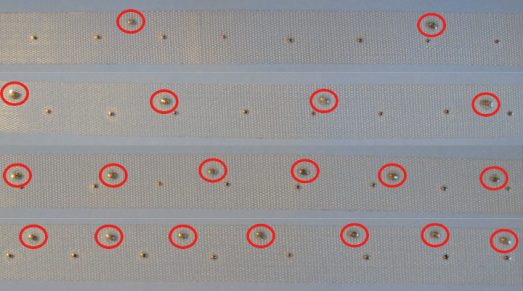Phosphorus is often under-applied
Key practice: In the seed row is the best time and place for the first 15 to 20 lb./ac. of phosphate — which is the amount most likely to produce an economic return in the year of application. However, this rate is not enough to match crop removal, which may lead to phosphorus shortages over time.
Key research: Grant, C.A., Agriculture and Agri-Food Canada
(AAFC), et al. “The importance of early season phosphorus nutrition,”
2001, Canadian Journal of Plant Science, 81(2): 211-224.
M. Nyborg and A.M.F. Hennig, AAFC. “Field experiments with
different placements of fertilizers for barley, flax and rapeseed,”
1969, Can. J. Soil Sci. 49: 79-88.
Phosphate applied in the seed row at rates of 15 to 20 lb./ac. (equivalent to 30 to 40 lb./ac. of monoammonium phosphate) should give each seed equal access to a droplet or prill without compromising seed safety. Seed safety, even at these rates, can be at risk in sandy soils using drills with very low seedbed utilization.
Nyborg and Hennig’s 1969 paper showed plant stand and yield benefits from seed-placed rates around 10 lb./ac. compared to no seed-placed phosphate. However, they also found that yield and plant stand started to fall at seed-placed rates above 20 lb./ac.
Cindy Grant et al, in the Canadian Journal of Plant Science review article “The importance of early season phosphorus nutrition,” emphasized the benefit to having phosphate available early in the season. “Early season limitations in P availability can result in restrictions in crop growth from which the plant will not recover,” they wrote.
Seed placement of phosphate addresses this early requirement, and is especially valuable in cool soils. That’s because temperature may influence the ability of the plant to access phosphorus during the early stages of crop growth. In cool temperatures, diffusion of phosphorus in the soil is slower, root growth is restricted, and phosphorus is less soluble.
Grant et all add that, “Since P will not move through the soil, it must be placed in a position where the plant roots can contact it early in the season. Placing the P in a band in or near the seed row allows the highest possible concentration of roots to contact and utilize the band soon after emergence.”

Grant also led a recent study called “Improving nutrient management in canola and canola-based cropping systems,” which was reported in the 2013 Canola Digest Science Edition. This study found that canola stand establishment was highest when only ammonium phosphate was placed in the seed row. Ammonium sulphate tended to increase seedling mortality, as did a combination of ammonium sulphate and ammonium phosphate. This study found that rates up to 20 kg/ha (roughly 20 lb./ac.) of phosphate seem to be the safest for stand establishment, which supports earlier work by Nyborg and Hennig.
The long-term management challenge for growers is that these seed-placed rates do not come close to matching the removal rates of current canola yields. Canola takes up 1.25 to 1.5 pounds of phosphate per bushel of yield, of which around 1 lb./bu. is removed with the seed, according to Canadian Fertilizer Institute estimates. A crop that yields 40 bu./ac. removes 40 lb./ac. of phosphate. Therefore seed-placed application rates of 15 to 20 lb./ac. are only meeting half the crop removal. Growers could apply the other half as a maintenance rate with their fertilizer blend applied outside the seed row or apply higher rates with cereal crops in the rotation.




